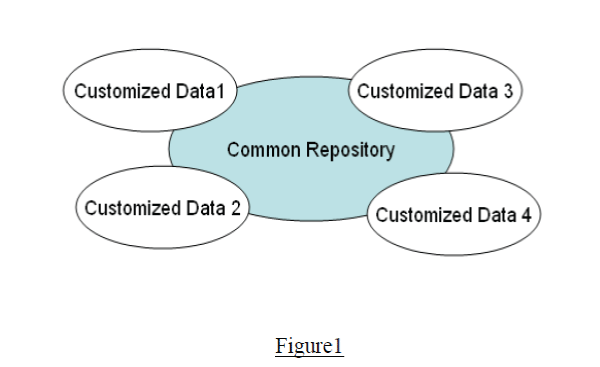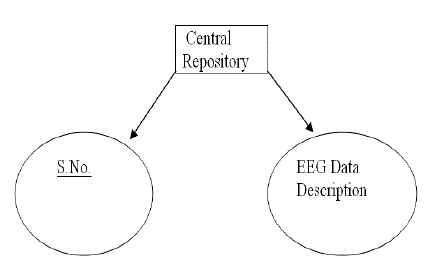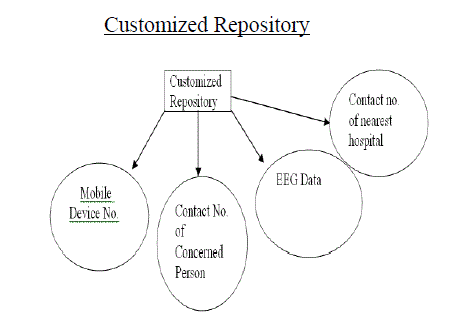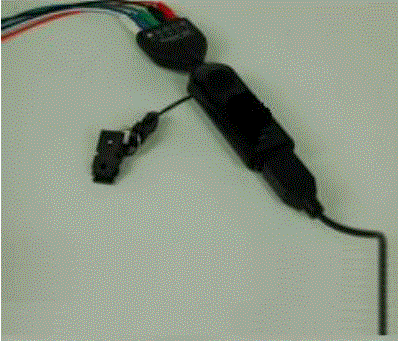Keywords
|
| EEG, mobile health, device, electrodes, android |
INTRODUCTION
|
| EEG can be used to pick up the signals from the scalp and such signals can be used to categorize the state of mind of the person, such signals can be seen on computer screen or handheld devices. EEG signals can be categorized into delta waves, theta waves, alpha waves, beta waves and gamma waves. This division has been done in terms of frequency different EEG signals are associated with different states of mind viz. sleep, arousal, alert, drowsiness, seizures and panic. |
| The EEG based panic tracker works on principle that while in panic situation a characteristic brain wave can be observed and based on that trigger is initiated. |
DESIGN PLAN
|
| Design plan of this device is divided into four phases: |
| A. Phase1 |
| Creation of device which can pick the EEG signals and send it to web application over the internet via GPRS through the mobile device. |
| B. Phase2 |
| Analysing brainwaves under different panic conditions viz. fear, suffocation, heart attack, intense pains etc. |
| C. Phase3 |
| Creating a central repository that contains all the possible combinations of EEG signals. |
| D. Phase4 |
| Creating application logic, for analysing the signals in repository with the signals received at the regular intervals and triggering the appropriate events. |
DESIGN DETAILS
|
| The design plan has been divided into four phases; this section will explain all the phases in detail. |
A. Phase1
|
| Phase1 deals with development of hardware required for carrying out the necessary functionality. Below is the list of hardware that would be required. |
EEG Machine
|
| The first thing that one can think of is conventional EEG machine but our requirements are entirely different i.e. conventional EEG machines require around 30-45 minutes to produce the EEG scan but our requirement was to get the scan every 3-5 minutes. Further, the output through the EEG electrodes is processed by standalone computer system but we required smaller processing unit. |
| Following are the major limitations that can be faced in the development of the solution proposed through conventional EEG machine:- |
| • More scanning time |
| • Processing has to be done on computer or laptop. |
| • Lack of mobility due large size of machine and the processing unit. |
| • More power input. |
| • More motion artefacts. |
Possible Alternative
|
| As mentioned above our requirement is to provide solution to all the problems mentioned above. |
Active Electrodes
|
| For picking up the electric activity from the scalp, the active electrodes need to be fixed in some structure which can keep the electrodes close in contact with the scalp. |
| Dealing with motion artefacts can be a problem, if we are placing EEG electrodes in the conventional way as it is done in EEG examination, so we required helmet like structure fitted with electrodes, such that at all the times electrodes will be in strong contact with the scalp. This will enable the mobility and reduce the motion artefacts to greater extent. |
Analog Circuit
|
| For acquiring, filtering and amplifying the signals from active electrodes. |
Digital Circuit
|
| Digital circuit will basically include includes A2Ds and a micro controller. It is designed to sample the analog signal and transfer it to the mobile device. |
Smart phone Application
|
| This can store all the data received in digital form and send it to internet over a regular interval of 5 seconds. |
| B. Phase 2 |
| Phase 2 is data preparation phase, here we have to stimulate different panic conditions and analyse the EEG, it’s a common practice to analyse EEG by inducing seizures by blinking high frequency lights similarly we can take EEG in different panic conditions such as heart attack, panic, intense pains and suffocation etc. |
| There can be two challenges while trying to induce such conditions:- |
| • Stimulation can be difficult, further EEG examination during such panic conditions may not be correct. |
| • EEG signals observed during stimulated conditions may not be the same for all individuals |
| Considering these two problems, the possible solution that can be there is to make the data more customizable. |
| Which means other than collecting the same data, we can also collect customized data, as per the individual i.e. we can customize the device as per the individual user. |
| So there would be two sets of data i.e. common data and the customized data. |
| As the data in Phase 1 would be in the digital form we can collect all the data in the digital form as the comparison of the digital data is easier than the comparison of analog data. |
| Other than data collection, the other major challenge is the choice of stimulants, which we need to select the commonly used stimulants such as Opioids and CNS depressants etc. can be used but for inducing any particular condition, the choice of stimulants can be found by clinical trials. |
| C. Phase 3 |
| This phase deals with creation of central repository i.e. internet website, to which request can be sent via smart phone’s android application to this central repository and response can be triggered accordingly. |
| As it has been discussed in phase 2 , there will be two repositories viz. |
| a) Customized Repository. |
| b) Common Repository. |
| The customized repository will be containing data as per the individual user data and Common repository contains generic data and data of other users as well. |
| This concept will be clearer from the picture below |
| Here as we can see that customized data is a subset of the data in common repository. Which means that common repository will contain data from all the customized repository in addition to the common data gathered during experimentation phase i.e. Phase 2. |
| The application logic will deal with managing these two data repositories which is common repository and customized repository. |
| D. Phase 4 |
| Phase 4 deals with creation of application logic. The phase 4 will be divided into two phase which is creation of application logic for hand held device and creation of application logic for website for managing the central and customized repositories. |
| Android application for smart phone (hand held) mobile device |
| EEG signal to mobile device would be sent in digital format now the application has to be such that by which digital signal is accumulated and transferred to internet website via GPRS. |
| Since there in no processing taking place in the hand held device, it would be easier to create the application logic. |
Web Application
|
| Web application hosted on internet will be expected to perform following set of functions:- |
| • Receiving data from mobile device |
| • Application must be able to receive data from mobile device and should be able to store it in database. |
| • Comparison of data |
| • Application must be able to compare the data received and the data stored in data repositories. |
| • Ability to trigger response |
| • The application must be send sms to concerned parties based on the data received. |
| • Ability to recognize the hand held device |
| The application must be able to recognize the hand held device for which data has been received. |
| Technical Specifications |
| As shown above the customized report entity in the database would consist of mobile device number, contact no. of concerned person, contact no. of nearest hospital and EEG data description. |
| Mobile Device Application Details |
| Platform: Android. |
| Input data: Digital-Received from EEG active electrodes |
| Web-Application Details |
| Platform: .NET Framework |
| Application: ASP.NET |
| Language: C# |
| 4) Database |
| E-R Diagram are shown above |
| DB: MySQL |
CONCLUSION
|
| EEG based panic tracker can provide next generation of health monitoring solution but there can be many challenges while creating such device both on hardware and software front. |
Figures at a glance
|
 |
 |
 |
 |
| Figure 1 |
Figure 2 |
Figure 3 |
Figure 4 |
|
| |
References
|
- O'Regan, S., Faul, S., &Marnane, W. "Automatic detection of EEG artefacts arising from head movements." Engineering in Medicineand Biology Society (EMBC), 2010 Annual International Conference of the IEEE, Buenos Aires, Argentina, August 31 - September 4,2010, 6353-6356(2010).
- Murphy, K., &Brunberg, J. "Adult claustrophobia, anxiety and sedation in MRI." Magnetic Resonance Imaging, 15(1), 51-54(1997)..
- Shackman, AJ; McMenamin, BW; Maxwell, JS; Greischar, LL; Davidson, RJ "Identifying robust and sensitive frequency bands forinterrogating neural oscillations". NeuroImage 51 (4): 1319–1333. doi:10.1016/j.neuroimage.2010.03.037. PMC 2871966 PMID 20304076(2010)..
- "New games powered by brain waves". Physorg.com. Retrieved 2010-12-02.DimitrisSacharidis, KyriakosMouratidis and DimitrisPapadias, ‘k-Anonymity in the Presence of External Databases’, IEEETransactions on Knowledge and Data Engineering, Vol. 22, pp. 392-404(2010).
- Sereno, S. C., Rayner, K., & Posner, M. I. Establishing a time-line of word recognition: evidence from eye movements and event-relatedpotentials. Neuroreport, 9(10), 2195-200. Retrieved from http://www.ncbi.nlm.nih.gov/pubmed/9694199(1998).
|